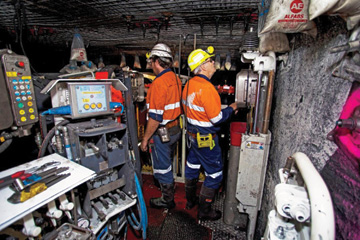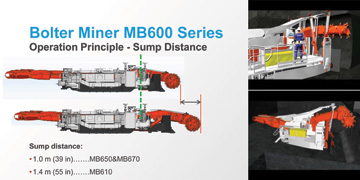The latest addition to Sandvik’s Bolter Miner family is the MB 610.
More than 20 years ago, Sandvik introduced the bolter miner to the coal mining industry with the first machine at Australia’s Tahmoor Colliery. The bolter miner concept quickly spread to other coal mining countries. Over time, with input from many longwall mines interested in improving advance rates, the machines continued to evolve.
The latest addition to Sandvik’s Bolter Miner family is the MB 610. With improved safety features and ergo-nomics, it was designed to increase productivity. In addition to flexible roof-bolting techniques, this bolter miner has demonstrated an improved life span for components. It is capable of cutting through hard intrusions as well.
The MB 610’s unique slow-cutting speed provides high-cutting forces, resulting in an increased cutting rate and reduced dust creation. Two of these machines are currently proving their worth at CONSOL Energy’s Bailey complex, which is one of five U.S. longwall mines operating two longwall faces. Working with the first machine, the development teams at the Bailey mine have advanced more than 56,000 ft, with an average shift advance of more than 120 ft during 2012.
One of the most important factors for longwall mining is panel development. The longwall panels must be mined before the active face reaches the stop line. With development, time is money. Many efforts have been made to increase development speed and improve safety. This article aims to show how hard rock cutting principles can be applied to longwall mining to improve performance and safety.
Introducing the Concept
The first Sandvik Bolter Miner was introduced to the Australian coal industry in the early 1990s. At the time, the machine was known as the ABM 20, which was designed and built by the Austrian company, Voest Alpine Bergtechnik, which was later acquired by Sandvik in the late 1990s. The machine showed its potential and it soon spread to other countries, including South Africa, the U.S., China and Russia. A total of 300 bolter miners have been delivered since inception and most are employed in longwall roadway development. They can also be used for room-and-pillar mining in soft rock operations such as salt mines and potash mines.
The MB 600 includes various models with different operating heights ranging from 7.5 to 14.5 ft. The U.S. predominantly uses the MB 450 and new MB 610. The MB 670 is popular in Canada.
The Operations Sequence
A bolter miner combines a roof- and rib-drilling machine and a continuous miner. It drills and bolts while it cuts and conveys coal to the rear of the machine. The key feature is the sliding frame, which allows simultaneous mining and bolting. The sliding frame carries the cutter-head and allows a longitudinal travel of 39 in. to 55 in., depending on the machine model, relative to the machine body, which carries the support and bolting units.
 The MB 610 now offers more space on the roof bolting deck and better lighting.
The MB 610 now offers more space on the roof bolting deck and better lighting.
The MB 610 trams on crawler pads and it uses hydraulic power to sump the sliding frame. As many as four roof-bolting rigs and two rib-bolting rigs can be integrated on the machine’s main frame.
A typical operating cycle begins by tramming the machine up to the face and putting it into the cutting position. Two to four stab jacks are lowered to the mine floor and an automated temporary roof support (ATRS) canopy is set against the roof. This guarantees a high level of safety for the roof bolters, who are working under the temporary roof.
The operating cycle continues with the bolting mode being engaged. The bolters start their activities. The cutter boom is raised and the loading apron is moved forward. They load the material toward the end of the machine.
The steps of the machine’s operation cycle are repetitive, which improves safety and reduces operational delays.
The stability of the machine and Sandvik’s cutting technology allows the same efficient coal cutting process to be used in harder cutting conditions, such as sandstone intrusions. Hydraulically controlled sump-in action on the cutter-head from a stabilized machine reduces the damage to the mine floor. An integrated system with ducts, curtains and water sprays controls dust at the face.
During the last year, a special emphasis has been placed on mine safety. Sandvik has made ergonomic improvements to the machine based on mine accident statistics from around the world. Improved lighting reduces the potential for tripping hazards. The size of operator platforms has been greatly increased and the controls are displayed in a much more ergonomic fashion. In fact, Australians are now using automated push-button controls for the bolters. The data coming from these control systems can be used to map the roof and create a strata profile.
About 20 years ago, Sandvik developed the wet-head spraying system for its roadheaders. Learning how different configurations operated, they modernized and simplified the system. The new design of water spray bars behind the cutter-head provides efficient dust suppression and improved methane ignition protection. Different spray configuration systems are available. For example, the incentive temperature protection (ITP) system or a combined water plus compressed air system reduces water consumption.
Adapting to U.S. Needs
In the U.S., the bolter miner was introduced as the ABM 14 in the late 1990s. The machine was designed with U.S. regulations in mind and the needs of U.S. coal operators. A top speed of 388 ft was achieved with that machine. Back then though, there was no rib bolting or chain mesh application for the roof. U.S. roof conditions have less spalling than Australia and Russia, which results in much faster development speeds. The machine provided the right tools for gateroad development to keep pace with increasing longwall productivity.
The most recent addition to the bolter mine product line is the MB 610 developed in close cooperation with U.S. coal operators. Some of the goals with this machine are increased safety and ergonomics, increased productivity, increased life span of components (longer times between rebuilds), the capability to cut hard intrusions, and more flexibility with bolting patterns.
The cutter-head with the MB 450 had a faster speed and less torque. The miners asked for better rock-cutting capability, more torque and less dust generation. The MB 610 has a 30-rpm rotation, which is much slower and allows better visibility. The increased torque also offers better penetration rates.
Compared to the predecessor models, life for the operator has been made much easier since Sandvik introduced the auto-cut cycle on the machine. It also improves the consistency of machine performance because of the workload optimization with standardized gearboxes and electric drives. At the same time, the automatic cutting cycle offers the best cutting pattern for any gateroad profile.
The slow cutting speed of 1.8 m/s or 30 rpm greatly reduced dust generation during cutting, contributing to a much healthier environment for the continuous miner operator and roof bolters. The slow cutting speed also reduced the risk of sparks, which helps prevent methane ignition.
 Once the MB 610 is stabilized with stab jacks, the cutter-head sumps and cuts coal while the roof and rib are bolted.
Once the MB 610 is stabilized with stab jacks, the cutter-head sumps and cuts coal while the roof and rib are bolted.
Controlling dust at the face is a prime concern and Sandvik’s knowledge with cutting tools and mining equipment allowed them to lower the cutting speed as compared to the industry-wide standard of 60 rpm. Higher torque and higher cutting forces also reduce noise levels.
The service life has been doubled, compared to the 450. At a weight of 120 tons, it has ample cutting stability. A clearance level of 79 in. allows the machine to be trammed around existing mine environments. It’s easy on the floor. Even though it’s a heavy machine, the stabilizers and wide crawler pads reduce the ground pressure to 25 psi.
It can turn very tight corners. It has a 256-in. cutting radius because of the unique system where the cutting head and loading table move independently. The bolting rigs tilt 37˚ giving greater flexibility. The new arrangement allows the first row of bolts to be placed within 110 in. of the face. Installing roof and rib bolts make the entire working area safer.
Because of the heavy weight of the MB 610 and the reduced cutting speed, it can achieve higher advance rates of 15% to 20% over prior machines.
The higher cutting force creates larger lumps and less dust. Creating less dust is not only a positive environmental affect, it also reduces the waste of energy over standard machines.
Lower cutting speeds also offer other benefits like cutting hard rock layers as well as reducing bit wear (consumption) due to less friction.
The MB 610 has data-logging capabilities, which helps mine management identify production bottlenecks. That information can be used to optimize processes underground. A machine status report can also be generated out of this system.
Slower cutting speeds also improve the life span of components especially in difficult ore cutting conditions, such as longwall development in the eastern U.S. coalfields.
An MB 610 was installed at CONSOL Energy’s Bailey mine in October 2011. Over the course of the next year, the machine cut 56,200 ft with average advance rate of 124 ft/shift. The best shift was 348 ft.
The gateroad conditions at the Bailey mine are 16- x 8-ft entries with 8- to 12-ft roof bolts and W straps. Two rib bolts are also installed on each cycle.
The machine was at the top of the totem pole in its first year. CONSOL now has two MB 610s operating at the Bailey mine and a third and fourth machine has been ordered and will be delivered soon. Slow cutting means faster development and increased safety and reliability throughout the entire operation.
Kirby Owen is product support manager, mechanical cutting, for Sandvik Mining and Thomas Vallant is the sales support manager, mechanical cutting, for Sandvik Mining. This article was adapted from a presentation they gave at Longwall USA 2013, which took place during June in Pittsburgh, Pa.


